Creating Stories
 Video 4.7
Video 4.7 Video 4.8
Video 4.8 Video 4.14
Video 4.14
Let’s say that one of your customers contracts you to design a brand-new magazine. As part of this graphic design project, you often start on paper, creating sketches of your ideas. Then, you gradually move up to mocking up rough layouts, using boxes and lines to indicate image and text elements. Finally, you create a composition in InDesign that will become the design proposal you submit to your client for approval.
Using Dummy Text
 ACA Objective 4.3
ACA Objective 4.3
At the design proposal stage, it is unlikely that you have received the text from actual magazine articles. Rather than randomly entering characters into a text frame, you can use fake filler text, often referred to as placeholder text, dummy text, or lorem ipsum (the Latin name). InDesign provides its own built-in placeholder text generator.
To add placeholder text to your document (Figure 4.24):
- Create a text frame with Type tool.
- Choose Type > Fill With Placeholder Text.

Figure 4.24 Filling a text frame with placeholder text
You can format the placeholder text with various character and paragraph formatting controls, changing the font, font size, leading, alignment, and other settings to build the design proof.
Working in Columns
 ACA Objective 3.4
ACA Objective 3.4 ACA Objective 4.1
ACA Objective 4.1 ACA Objective 4.2
ACA Objective 4.2
Magazine layouts often contain multiple short stories on a single page and run feature stories across multiple pages. A column-based layout grid provides a great starting point for designing magazine pages (Figure 4.25). With a grid, you can resize design elements based on the column widths; position images across one, two, or three columns; and flow the text across the columns for easy reading (Figure 4.26). As mentioned in the previous chapter, working in threes allows you to apply the rule of thirds when designing.
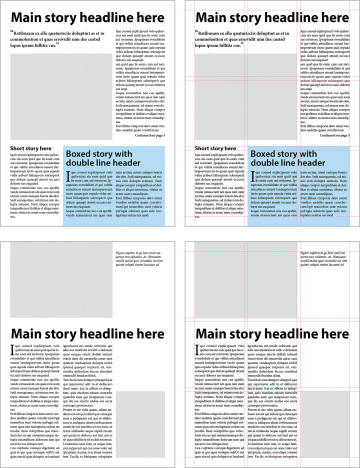
Figure 4.25 Page designs that use a three-column grid
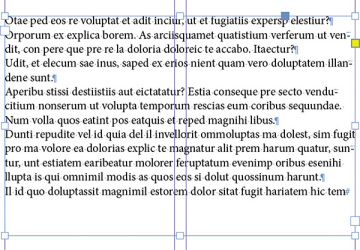
Figure 4.26 A text frame stretched to the width of two columns
In a multicolumn layout, text frames may be stretched across multiple columns. Text will flow to the width of the overall text frame.
You could opt to create narrower text frames by matching the frame width to the column width. However, that would require you to create and thread multiple text frames, and then adjust those text frames for each change in text and layout. Rather than using multiple text frames, a single text frame can be divided into columns.
Changing the Number of Columns
To change the column settings for a text frame (Figure 4.27):
- Select the text frame with the Selection tool.
- In the Control panel, enter a new value in the Number of Columns field or click the arrows next to it.
- Enter a value in the Gutter field to change the amount of space between columns.
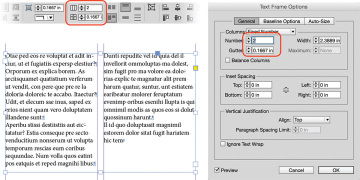
Figure 4.27 Changing a single-column text frame to two columns
You can also change the number of columns while setting other options for the text frame:
- Select the text frame with any tool.
- Choose Object > Text Frame Options.
- In the Columns area of the General tab, enter a new value in the Number field.
- Enter a new value in the Gutter field to change the amount of space between columns.
- Modify any other settings in the Text Frame Options dialog box, such as Inset Spacing.
- Click OK.
Changing Text Frame Inset
When you apply a background tint to a text frame to make a story stand out, the text can end up too close to the edges of the frame. To give the text a little space, change the Inset Spacing values in the General tab of the Text Frame Options dialog box (Object > Text Frame Options).
Spanning Paragraphs Across Columns
Magazine articles often include a heading that needs to span across all columns. There is no need to place such a heading in a separate text frame. InDesign has a cool feature that lets you span text across multiple columns.
To span a heading across multiple columns (Figure 4.28):
- With the Type tool, click anywhere in the heading’s paragraph.
- In the Control panel, choose Span All from the Span Columns menu.
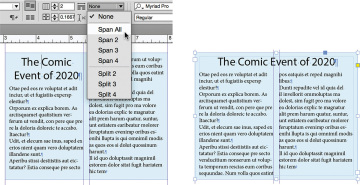
Figure 4.28 Spanning the header text across the columns
Aligning Text Across Columns with a Grid
When you have various stories in different text frames or text frames with multiple columns, you may notice that the lines of body copy do not line up horizontally across the page. This may be due to variations in the positioning of individual text frames. If you want to align this text—which is a design choice in itself—you can use ruler guides and nudge text frames up or down (Figure 4.29). This is a tedious way to achieve this result, however. A better option is to align the body copy, which generally has the same font size and leading, to a baseline grid. This baseline grid is set up to match the leading used for the body copy.
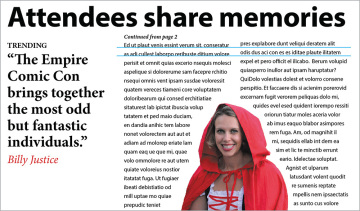
Figure 4.29 Two text frames placed side by side in a layout, with the body copy set to the same font size and leading. The two columns are set as individual text frames, causing the body copy text to not align across the columns.
To set up a document-based baseline grid (Figure 4.30):
- Using the Type tool, click in a paragraph of body copy. Note the value in the Leading field on the Control panel or Character panel.
- Choose Edit > Preferences (Windows) or InDesign CC > Preferences (Mac OS), click Grids in scroll list at left.
- Under Baseline Grid, enter the leading value in the Increment Every field.
- Fine-tune the grid with other options, including the color of the guides, where it starts, and at what zoom levels it is visible. Click OK.
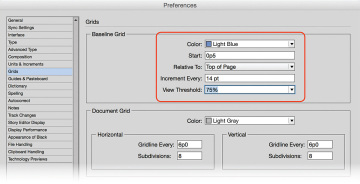
Figure 4.30 Setting up the baseline grid for a document
To see the baseline grid (Figure 4.31):
- If necessary, choose View > Screen Mode > Normal.
- Specify a zoom at level at or above the percentage value in the View Threshold field in the Preferences dialog box (Grids > Baseline Grid).
- Choose View > Grids & Guides > Show Baseline Grid.
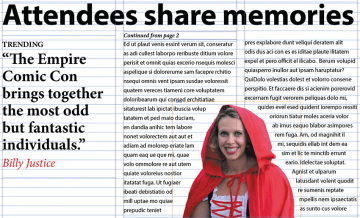
Figure 4.31 Baseline grid visible
The final step is locking the paragraphs of body copy to the baseline grid.
To align text to the baseline grid (Figure 4.32):
- Select the paragraphs with the Type tool.
- In the Paragraph panel or the Control panel, click the Align to Baseline Grid icon.
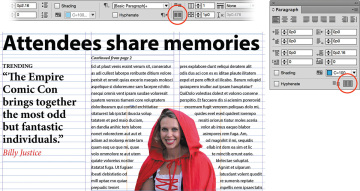
Figure 4.32 Aligning body copy to a baseline grid
In addition to the different guides you can use to align and position objects, you have now learned to work with a baseline grid. InDesign features one more grid: the document grid. When you choose View > Grids & Guides > Show Document Grid, a gray mesh appears over your document (Figure 4.33). The preferences for the Document Grid are set in the Grids preferences, similar to where you set up the Baseline Grid.

Figure 4.33 The Document Grid displayed (View > Grids & Guides > Show Document Grid)
Threading Text Frames
 ACA Objective 4.3
ACA Objective 4.3 Video 4.10
Video 4.10 Video 4.11
Video 4.11
When talking about a story in InDesign, we are referring to a continuous piece of text that fits within a standalone text frame or flows among a series of threaded (linked) text frames. A longer feature story in a magazine will likely continue on another page in the magazine and require text frame threading.
Text frames have an in port at the top left and an out port at the lower right (Figure 4.34). These ports connect text frames together and allow text to flow across frames. When there is more text than can fit in a frame, the out port displays a red plus sign. This is referred to as overset text.
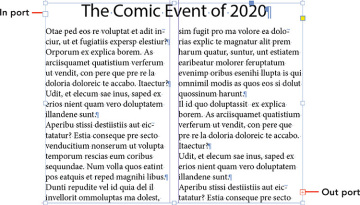
Figure 4.34 Each text frame has an in port and out port. When the out port shows a red plus sign, the text is overset.
The Story Editor
To see all of the text in an overset text frame, view the story in the Story Editor. The Story Editor is a simple editing window that shows “raw text” without formatting or the surrounding layout. It does, however, show you overset text, making it a very useful editing tool.
To see the overset text in the Story Editor (Figure 4.35):
- Select the overset text frame.
- Choose Edit > Edit in Story Editor.
- In the Story Editor window, scroll to the bottom of the story to see text marked as overset.
- You can click in the text and edit it, or at least communicate to an editor how many lines need to be cut.
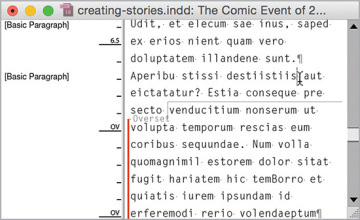
Figure 4.35 The Story Editor window with overset text shown
Threading Text Frames
For shorter stories, you might be able to fix overset text by slightly expanding the text frame or editing the text. However, for longer stories, threading text frames to continue the story elsewhere is the preferred way. As you resize text frames on one page, the text that no longer fits in the first text frame will automatically flow to the next frame and so on.
To continue overset text on another page and thread text frames (Figure 4.36):
- Using the Selection tool, select the text frame that contains overset text.
- Click the text frame’s out port.
- The pointer turns into a loaded text icon, with the text of the story attached to it.
- Using the Pages panel or other navigation options, display the page where you want to continue the text.
- Drag to create a new text frame to contain the overset text.
- If the text is still overset, you can repeat steps 2 through 5 to create another threaded text frame.
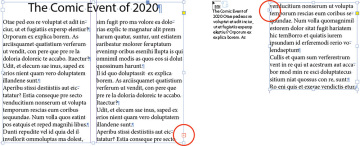
Figure 4.36 Clicking the out port of an overset text frame loads the Selection tool pointer. The text is threaded to a new text frame, and its out port changes to a small triangle.
The frame will fill with the remainder of the text. The out port on the previous page, and the in port on the new text frame, display a small triangle to indicate that the text frames are part of a series of threaded text frames.
Creating Jump Lines
When a story continues on a different page, a jump line tells the reader where to find the remainder of the story. Jump lines tell the reader on which page they can continue to read the story, or where a story is continued from.
To add a “continued on” jump line (Figure 4.37):
- Start by creating a small text frame.
- Enter a phrase such as, “Continued on page.”
- With the text insertion point at the end of the line, choose Type > Insert Special Character > Markers > Next Page Number.
- Using the Selection tool, position the text frame so that it touches or slightly overlaps the text frame of the story that continues.
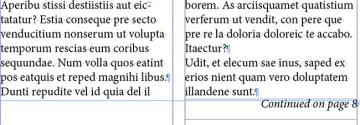
Figure 4.37 A jump line for a story that continues on another page
Wrapping Text Around Images
 ACA Objective 4.2
ACA Objective 4.2 ACA Objective 4.4
ACA Objective 4.4 Video 4.9
Video 4.9 Video 4.14
Video 4.14
In Chapter 2 you learned about the image and graphics file formats that are supported in InDesign as well as different techniques for placing images. If you remember, options for importing images include placing images directly onto the page by dragging with the loaded graphics icon ( ) or placing graphic content into existing placeholder frames. Once images are on the page, you can resize them within the frame or resize the image and frame simultaneously.
) or placing graphic content into existing placeholder frames. Once images are on the page, you can resize them within the frame or resize the image and frame simultaneously.
Creating Placeholder Frames
When you move the loaded graphics icon over an empty placeholder frame, its appearance changes by adding parentheses ( ). The parentheses indicate that when you click, InDesign will insert the image into the frame at 100% of its original size and centers it in the frame (Figure 4.38).
). The parentheses indicate that when you click, InDesign will insert the image into the frame at 100% of its original size and centers it in the frame (Figure 4.38).

Figure 4.38 An image placed in a circular graphics frame created with the Ellipse tool
If you plan to place images into nonrectangular frames, you might want to create placeholder frames first.
Fitting Images in Placeholder Frames
When you place an image into a placeholder frame, you need to resize and position the image after it’s added to the page. To fast-forward that process, use one of the Object > Fitting controls or click the equivalent icon in the Control panel (Figure 4.39).

Figure 4.39 Different frame-fitting options
Enabling Text Wrap
Images placed over text will overlap the text. Text wrap lets you flow the text around an object, an image’s rectangular bounding box, or image contours.
To wrap text around a bounding box (Figure 4.40):
- Position an image over text, and keep the graphics frame selected.
- Choose Window > Text Wrap.
- Click the Wrap Around Bounding Box icon.
- In the Text Wrap panel, enter new Offset values or click the arrows next to the fields. You can enter a negative value if needed.
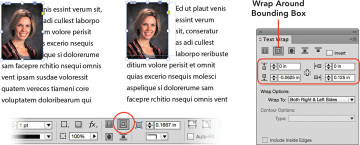
Figure 4.40 Text wrapped around the image’s bounding box
To wrap text around the shape of the graphic frame itself (Figure 4.41):
- Using the Selection tool, select the graphic frame.
- In the Control panel or Text Wrap panel, click the Wrap Around Object Shape icon.
- In the Text Wrap panel, select Graphic Frame from the Contour Options Type menu.
- Enter new Offset values as needed.
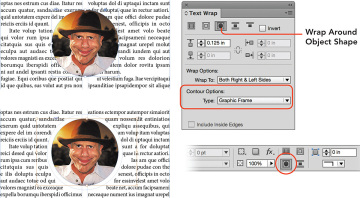
Figure 4.41 Wrapping text around the circular graphics frame
If an image has a transparent background, such as a Photoshop (PSD) image, you can also wrap the text around the shape of the nontransparent image (Figure 4.42):
- Select the image.
- In the Control panel or Text Wrap panel, click the Wrap Around Object Shape icon.
- Under Contour Options, select Alpha Channel from the Type menu. If an alpha channel is not saved with the image, select Detect Edges.
- Select Transparency from the Alpha menu.
- Enter a new value in the Offset field as preferred.
- To avoid a line of text being interrupted by text wrap, select Largest Area from the Wrap To menu (Figure 4.43).
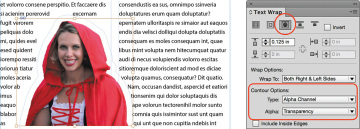
Figure 4.42 Wrapping text around an image with a transparent background. Note the line of text that is broken up in the left column.
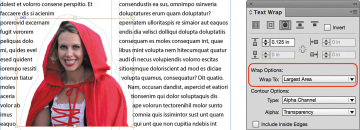
Figure 4.43 Fix the broken line in the left column by changing the Wrap To setting to Largest Area.
Turning Text into Images
 ACA Objective 4.4
ACA Objective 4.4 Video 4.12
Video 4.12
To make story headlines stand out, designers generally apply a larger font size and, sometimes, different colors and effects. Another creative effect that works well with larger text is to replace the text fill color with an image. For example, imagine the headline “Leopard Man at Comic Con” with the text in a leopard skin pattern or grunge text with a weathered, rough look.
Before you can place an image into text, however, you must first convert the text to a frame. There’s one slight downside: Once you convert the text, you can no longer change the text itself. So keep a copy of the text on the pasteboard, so you have an easy fallback option if needed.
There are two ways to do this:
Convert all the text in the frame: Using the Selection tool, select the text frame, then choose Type > Create Outlines. This converts the text into a compound path, which is a series of paths that behave as a single frame or a group. Once selected, you can place a graphic inside the compound path (Figure 4.44).

Figure 4.44 Converting all the text in a frame to outlines
Convert selected text: Using the Type tool, select the text to convert, then choose Type > Create Outlines. In this case, only the text you selected is converted. The new text-shaped frame is anchored in the text at its original location (Figure 4.45).

Figure 4.45 Converting selected text to outlines
When you move the Direct Selection tool over the converted text, you can see all the anchor points and line segments (Figure 4.46).

Figure 4.46 Text converted to outlines results in a text-shaped frame.
To insert an image (Figure 4.47):
- Using the Selection tool, click to select the text-shaped frame.
- Choose File > Place and navigate to the image file. Select it and click Open.
- With the frame still selected, choose Object > Fitting > Fill Frame Proportionally to fill the text shape with the image.

Figure 4.47 A blue pattern placed inside the converted text
You can also adjust the image placement using the Selection tool: Click the Content Grabber inside the frame and drag to position the image, or select one of the image bounding box handles and Shift-drag to resize.